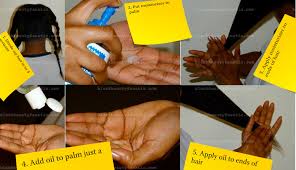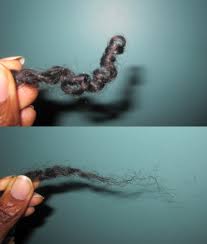Now that I moisturise and seal (with oil) my hair
every day, I find that my hair remains softer and more manageable. More
moisturised and smooth. Even my new growth is more tamed.....looks and feels
stronger and healthier. I use oils a lot in my regimen. There is no day I don’t
put castor oil and /or coconut oil, almond oil, jojoba oil, amla oil in my
hair. What is in the oils? I decided to check out what the oils being used in
hair care regimens really contained. What was making them work; reviving
damaged, dull and weak hair?
 |
| How to moisturise and seal hair. |
I found articles that spoke about Ceramides months
ago. I tried to digest properly the information I had gathered over time. What
first caught my eye was this list published by a lot of bloggers especially that
was supposed to give the percentages of ceramides found in the oils and others.
Safflower oil 78%
Grape seed oil 73%
Poppyseed oil 70%
Sunflower oil 68%
Hemp oil 60%
Corn oil 59%
Wheat germ oil 55%
Cottonseed oil 54%
Soybean oil 51%
Walnut oil 51%
Sesame oil 45%
Rice bran oil 39%
Pistachio oil 32.7%
Peanut oil 32% [17]
Canola oil 21%
Egg yolk 16%
Linseed oil 15%
Lard 10%
Olive oil 10%
Palm oil 10%
Cocoa butter 3%
Macadamia oil 2%
Butter 2%
Coconut oil 2%
In order to be super sure, I decided to research
more into the percentages being quoted. I luckily came across one forum where
someone else posted that the percentages quoted were not of the Ceramide
content but of the percentages of Linoleic Acid (LA) found in those oils!!
After a long search, I found the site where the list
was initially posted only to find out the lady was right. The article
associated with it presents this list as substances mainly natural oils and
their percentages of Linoleic Acid. (Source: http://www.news-medical.net/health/Oils-Rich-in-Linoleic-Acid.aspx)
 |
| The importance of oils in hair care |
CROSSROADS: Ceramides, Lipids and Linoleic Acid (LA) – Which is Which
and what are they?
(Welcome to today’s class in Chemistry)
Linoleic acid (LA): is a polyunsaturated fatty acid used in the
biosynthesis of arachidonic acid (AA) and thus some prostaglandins. It is found in the lipids
of cell membranes. It is abundant in many vegetable oils, comprising over half
(by weight) of poppy seed, safflower, sunflower, and corn oils.
Ceramides:
They are naturally occurring lipids (or fatty materials) found in the
hair fiber or naturally in the skin. A ceramide is a lipid molecule, which are
naturally occurring molecules such as sterols and fats. Lipid's have one of
three functions -- they make up part of the structure of a cell's membrane,
storing energy or signaling actions in cells. Ceramide is a structural and
signaling molecule. It is made up of a fatty acid called sphingosine and is
located within the membrane of cells, in great concentrations. These cells can
be found on the surface layer of your skin. The ceramide lipids limit the loss
of water from your skin and acts as a barrier against harmful substances penetrating
your skin. (Source: Yahoo answers)
More on Ceramides: They are rarely found as such
at greater than trace levels in tissues, less than 10% of the glucosylceramide
content in plants for example, although they can exert important biological
effects. Ceramides are formed as the key intermediates in the biosynthesis of
all the complex sphingolipids, in which the terminal primary hydroxyl group is
linked to carbohydrate, phosphate, etc. Unlike the sphingoid precursors, they
are not soluble in water and are located in membranes where they participate in
raft formation. (Source: http://lipidlibrary.aocs.org)
Lipids : They are molecules that contain
hydrocarbons and make up the building blocks of the structure and function of
living cells. Examples of lipids include fats, oils, waxes,
certain vitamins, hormones
and most of the non-protein membrane of cells. They can be extracted from
plants and animals using nonpolar solvents such as ether, chloroform and
acetone.
(Source: http://www.news-medical.net/health/What-are-Lipids.aspx)
 |
Source : www.darkerthanbrown.blogspot.com
|
Importance of Ceramides in Hair Care:
Ceramides are moisture capturing lipids which are
very beneficial to chemically treated hair and hair that undergoes a lot of
manipulation. Many hair products especially conditioners contain synthetic or
lab-created ceramides to help replace the ceramides naturally lost from the
hair during regular washing, styling, and chemical treating. These help to hold the hair cuticle together
resulting in smooth and lustrous hair. They help to quickly improve the
appearance of damaged hair by strengthening the cuticles which result in less
breakage and split ends.
 |
| Good hair versus bad hair |
MY
CONCLUSION: Bottom line is, though ceramides are supposed to occur
naturally on our skin (and scalp), most of us lose a lot of this molecule made
up of fatty acid through the treatments we give to our scalp. Overuse of
chemicals and heat, dirt build-up and improper scalp care. This important substance
is depleted leaving our hair dry, dull, weak and unhealthy.
All those oils and substances listed are great
for our hair because they are Lipids, and therefore contain Linoleic Acid and
wherever you find Linoleic Acid, you often find Ceramides. This presupposes
then that the more Linoleic Acid found in the substance, the more Ceramide content
you may find (assumption) which makes it a better choice for moisture retention
and cuticle smoothing.
Reach out for those oils and try them out on your
hair. They are sure to help boost the production of ceramides naturally. Remember
however, that ceramides cannot replace the function of protein in your regimen.
As always, protein-moisture balance is essential!!
Drop a comment if you're using oils in your regimen and share your experiences with us. Do not hesitate to grab some oil if you're new to the concept and share your experiences after a week or two. I’m sure to grab a bottle of Sunflower oil the
next time I go to the market as that one is quite common, but holla at me if you
find grape seed oil anywhere!!
Cheers,
Star.

